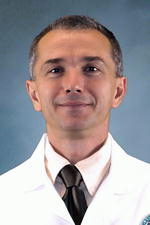The 2013-2014 Pilot Project award recipients are Kenneth D. Mitchell, Ph.D., Ryosuke Sato, Ph.D., and Ihor V. Yosypiv, M.D.
 Kenneth D. Mitchell, PhD
Kenneth D. Mitchell, PhD
Professor,
Department of Physiology
Phone: (504) 988-2593
Room #: 4055
Email: kdmitch@tulane.edu
PDGF Receptor Blockade Reverses the Renal Functional and Morphological Changes that occur in Angiotensin II-Dependant Hypertension.
Dr. Mitchell completed his PhD from the University of Edinburgh, Scotland, United Kingdom, in 1986 and his Postdoctoral fellowship from the University of Alabama at Birmingham. His pilot project study will resolve the conundrum regarding the mechanisms by which elevated ANG II levels lead to renal derangements in disease conditions but not in physiologically appropriate settings. This contribution is significant as it will provide a new paradigm that pressure-dependent increases in PDGF receptor activation contribute to the the renal functional and morphological changes in ANG-II-dependent hypertension.
PILOT PROJECT RESEARCH: Angiotensin II (ANG II)-mediated hypertension is characterized by increases in intrarenal ANG II levels, renal functional derangements, and renal injury. However, increased intrarenal ANG II levels alone in the absence of elevated arterial pressure are not associated with derangements in renal hemodynamics or perceptible renal injury, and ANG II-induced renal functional and morphological derangements occur primarily in a setting of elevated arterial pressure. These findings indicate that elevated intrarenal ANG II levels alone are insufficient to cause derangements in renal hemodynamic function and renal injury. In this regard, additional factors such as growth factors, cytokines, and various other paracrine agents, such as extracellular PDGF, directly augmented by the elevated arterial blood pressure may contribute to the renal functional and morphological derangements in ANG-II-dependent hypertensive states. In this regard, we have previously demonstrated that chronic blockade of PDGF receptors with imatinib mesylate ameliorated the renal functional and morphological derangements in Cyp1a1-Ren2 transgenic rats with ANG II-dependent malignant hypertension. However, it remains unclear whether chronic PDGF receptor blockade can actually reverse the renal functional and morphological derangements that occur following transient induction of ANG II-dependent hypertension in Cyp1a1-Ren2 transgenic rats. In vivo renal clearance experiments will be performed to determine the effects of blockade of PDGF receptors on the renal functional derangements that occur following transient induction of slowly progressive ANG II-dependent hypertension. Additional histological and immunohistochemical studies will be performed to determine if chronic PDGF receptor blockade can reverse the renal injury that occurs following transient induction of ANG-II-dependent malignant hypertension in Cyp1a1-Ren2 rats. The results obtained will establish whether chronic PDGF receptor blockade can reverse the renal functional and morphological derangments that occur following transient induction of ANG II-dependent hypertension and, therefore, provide new information regarding the ANG II-independent renal functional and morphological changes that occur in ANG II-dependent hypertension.
 Ryosuke Sato, PhD
Ryosuke Sato, PhD
Instructor
Department of Physiology,
Phone: (504) 988-4364
Room # M763
Email: rsato@tulane.edu
Angiotensinogen Expression and Regulation in Renal Proximal Tubules during the Development of Angiotensin II-Dependent Hypertension.
Dr. Ryosuke Sato is an Instructor at Tulane University. He earned his PhD from Gifu University in 2005. His proposed pilot project study will provide a novel and more effective approach for delineating mechanisms underlying the development of hypertension and RAS associated kidney injury in Ang II-dependent hypertension.
PILOT PROJECT RESEARCH: Elucidating mechanisms underlying intrarenal angiotensinogen (AGT) regulation is an essential subject for development of strategies to treat hypertension and renin-angiotensin system (RAS) associated kidney injury. AGT concentration in rat proximal tubules is greater than AGT concentration in plasma. Although the high levels of intratubular AGT can contribute to high levels of renal tubular angiotensin II (Ang II), mechanisms underlying the development of the high AGT levels are still unclear. Recent studies have suggested that early renal proximal tubules (S1 segment) do not express AGT mRNA under normal conditions. In addition, one of these studies 3 and our preliminary data show that S2 cells in renal convoluted tubules strongly express AGT mRNA. However, the distribution of AGT expression in renal proximal tubules of Ang II-dependent hypertension has not been delineated. There is an evidence that a small amount of circulating AGT spillovers into kidney and is internalized into proximal tubular cells (PTC) via megalin leading to accumulation of AGT protein in PTC. However, plasma AGT concentration is lower than that in renal tubules. Furthermore, megalin levels are downregulated by Ang II in PTC, suggesting that internalization of circulating AGT in PTC may not largely contribute to augmentation of intrarenal AGT levels during Ang-II-dependent hypertension. Accordingly, objectives of the proposed study is identification of the primary source of AGT in renal proximal tubules and demonstrating augmentation of AGT production in the segment of Ang II-dependent hypertensive animals will be essential. Therefore, the following specific aims will be achieved: Specific Aim 1. To determine expression levels of AGT and their regulations by Ang II and/or IL-6 in cultured mouse S1, S2 and S3 cells. Specific Aim 2. To demonstrate elevation of AGT production in renal proximal tubules of Ang II-dependent hypertension. These results will determine the main source of intratubular AGT and provide firm evidence that AGT production is increased in renal proximal tubules during the development of Ang II-dependent hypertension.
 Ihor V. Yosypiv, MD
Ihor V. Yosypiv, MD
Associate Professor
Department of Medicine/Section of Pediatrics,
Phone: (504) 988-1026
Room #: 5534
Email: iiosipi@tulane.edu
Angiotensinogen Expression and Regulation in Renal Proximal Tubules during the Development of Angiotensin II-Dependent Hypertension.
Dr. Ihor Yosypiv completed his postdoctoral research training in developmental nephrology. Dr. Yosypiv is a clinician with an interest in Pediatric end-stage renal disease and congenital renal disorders and is actively involved in laboratory research in congenital anomalies of the kidney and urinary tract. The objective of his pilot project proposal is to define the molecular mechanisms by which aberrant PRR signaling in the kidney ureteric bud and collecting duct regulates development and function of the renal collecting system. The outcome will contribute to an increased understanding of the molecular and pathophysiological derangements that lead to CAKUT, RHD and associated hypertension in children.
PILOT PROJECT RESEARCH: Congenital anomalies of the kidney and urinary tract (CAKUT), including renal hypodysplasia (RHD), occur in 1 in 500 live births, are the leading cause of end-stage kidney disease ESKD in children, placing an enormous burden on our health-care system. Notably, up to 70% of children with ESKD develop hypertension. Although Prorenin receptor (PRR) is emerging as a critical new player in angiotensin II-dependent hypertension, its role in CAKUT and RHD in children is unknown. Our preliminary data demonstrate that PRR is expressed in the ureteric bud (UB) and collecting duct of the developing metanephros and that targeted genetic inactivation of the PRR in the UB lineage in mice results in congenital RHD. The mechanisms whereby PRR mutations cause RHD are unknown. Our long-term goal is to investigate the mechanisms by which an intact the UB/collecting duct PRR controls proper kidney development, collecting duct cell differentiation and function, and how aberrationt PRR signaling in the collecting duct results in RHD. The specific aims are: Aim 1. Test the hypothesis that UB PRR promotes differentiation of CD cells via induction of intercalated cell fate. Aim 2. Test the hypothesis that UB PRR is essential for acquisition of function by the intercalated cells of the CD. This study will allow to open new avenues of understanding applicable to the care of infants and children with CAKUT, RHD, hypertension and distal renal tubular acidosis.
